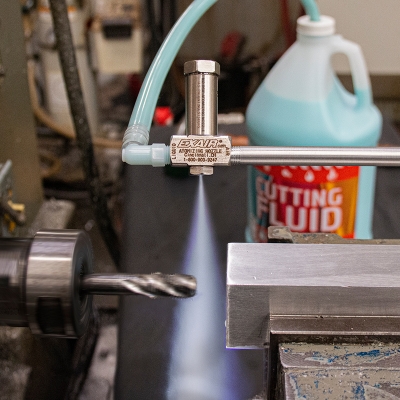
EXAIR’s new 1/8 NPT No Drip Siphon Fed Air Atomizing Spray Nozzles provide consistent and even flow of non-pressurized liquid for applications like marking, lubricating, rinsing, cooling, quenching, wetting (moistening), dust control and humidification. The intelligent design of this Siphon Fed spray nozzle allows for the absence of liquid pressure and in turn, uses gravity fed liquids or lifted liquids from a siphon height of 36 inches (91cm) with the added benefit of positively stopping liquid flow when compressed air is shut off.
Post spray drips waste precious resources such as expensive coatings, chemicals or water, and unwanted drips can ruin product function on sealing or mating surfaces as well as ruin the appearance of painted or coated finishes. EXAIR’s No Drip Atomizing Nozzles are ideal for these situations where no post-spray drip is permissible. When the compressed air supply is shut off, the no drip nozzle positively seals off the flow of liquid eliminating the possibility of drips.
EXAIR's No Drip Siphon Fed Atomizing Nozzles are available in round and flat fan liquid patterns. The volume of liquid flow depends on either the gravity or suction height coupled with air pressure. All of EXAIR’s spray nozzles, which include nozzles for pressure fed applications, are composed of 303 stainless steel adding durability and corrosion resistance. They are available with 1/8, 1/4 or 1/2 NPT inlets with a variety of styles, flow rates and liquid patterns. Mounting brackets are also available for easy installation in specific areas on product lines. They are CE compliant and conflict mineral free.
Contact Details
Related Glossary Terms
- corrosion resistance
corrosion resistance
Ability of an alloy or material to withstand rust and corrosion. These are properties fostered by nickel and chromium in alloys such as stainless steel.
- flat ( screw flat)
flat ( screw flat)
Flat surface machined into the shank of a cutting tool for enhanced holding of the tool.
- quenching
quenching
Rapid cooling of the workpiece with an air, gas, liquid or solid medium. When applicable, more specific terms should be used to identify the quenching medium, the process and the cooling rate.







